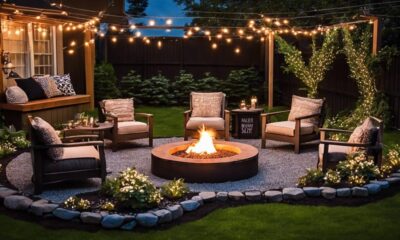Retreat
The Business of Retreats: Marketing Strategies for Success
Master the art of retreat marketing with strategies that captivate your audience and elevate your brand—discover the secrets that will set you apart.
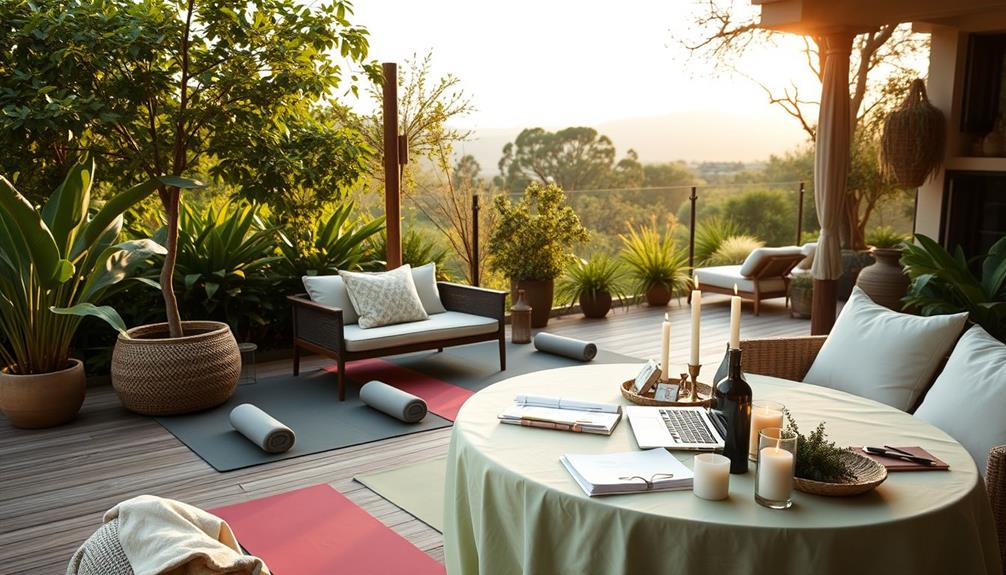
To succeed in the business of retreats, you need to start by understanding your audience. Conduct market research to create detailed buyer personas and identify their specific needs. Leverage social media to engage with users through compelling visuals and interactive content. Build a strong online presence with SEO optimization and participant testimonials that establish credibility. Craft marketing campaigns that highlight your unique selling proposition and adjust based on feedback. Finally, foster a community through local partnerships and wellness events. These strategies can greatly enhance your retreat's appeal and effectiveness, and there's more valuable insight ahead.
Key Takeaways
- Conduct thorough market research to understand demographics, preferences, and wellness trends tailored to your target audience.
- Develop a strong online presence through SEO optimization, engaging content, and showcasing participant testimonials to build credibility.
- Utilize social media strategies, including engaging visuals and community participation, to enhance visibility and foster emotional connections.
- Create compelling marketing campaigns with a unique selling proposition and leverage testimonials to establish trust and attract attendees.
- Foster partnerships with local businesses and influencers to enrich experiences and broaden reach through collaborative wellness events and exclusive offers.
Understanding Your Audience

Understanding your audience is the cornerstone of effective marketing for retreats. By identifying your target, you'll open up the potential for crafting tailored marketing messages that resonate deeply. Start with market research to gather insights about your audience's demographics and psychographics, such as age, income, and lifestyle preferences. This knowledge allows you to develop detailed buyer personas that represent your ideal attendees.
Additionally, embracing the benefits of curiosity can enhance your understanding of your audience, leading to more innovative and engaging marketing strategies.
Next, plunge into understanding their specific needs and desires. Utilize surveys and feedback mechanisms to gain deeper insights into audience preferences, which will help differentiate your marketing approaches. By prioritizing audience engagement, you can create an emotional connection with potential participants, making them feel understood and valued.
Additionally, keep an eye on trends in wellness that resonate with your target demographic. This awareness not only enhances your marketing strategies but also guarantees you're meeting the evolving interests of your audience.
Ultimately, by mastering the art of understanding your audience, you'll position your retreat for success, driving participation and fostering a loyal community that aligns with your mission.
Leveraging Social Media

Once you've grasped who your audience is, it's time to harness the power of social media to amplify your retreat's visibility. With over 3.6 billion users globally, platforms like Instagram and Facebook are essential for retreat marketing. Focus on creating engaging content that resonates with your target audience, such as live Q&A sessions or polls, which can boost interaction rates considerably.
Visual storytelling is another key element; high-quality images and videos of past retreats can foster emotional connections and enhance shares by 94%. Consistent posting and active participation in wellness-related communities can lead to a 67% increase in audience engagement, which helps build trust with potential attendees.
Here's a quick overview of effective strategies:
| Strategy | Benefit | Example |
|---|---|---|
| Engaging Content | Increases interaction | Live Q&A sessions |
| Visual Storytelling | Enhances emotional connection | High-quality videos |
| Consistent Posting | Boosts online visibility | Regular updates |
Building an Impactful Online Presence
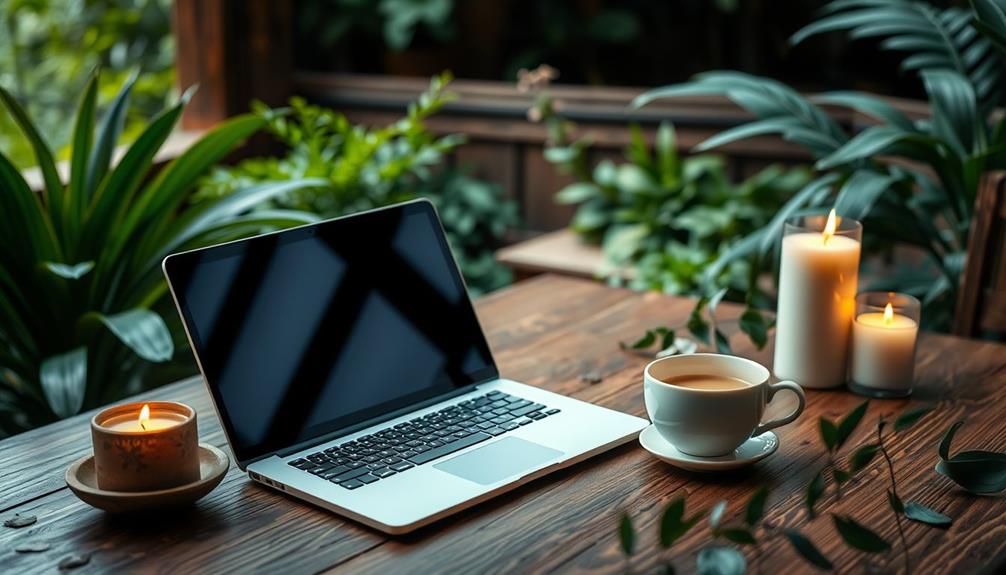
Creating an impactful online presence is essential for attracting attendees to your retreat. To effectively market your unique experiences, consider these strategies:
1. Optimize for SEO: Use relevant keywords throughout your website to enhance visibility. This helps potential guests find your retreat easily, making your online presence more effective.
Incorporating uplifting themes, similar to those found in songs like Blue Skies and Lemonade, can further boost your appeal to guests seeking positivity.
2. Engage with Content Delivery: Regularly update your blog with informative posts about wellness and retreats. This not only establishes your authority but also keeps your audience engaged and informed.
Sharing insights on techniques for creating thematic coherence in your offerings can resonate with your audience and deepen their interest.
3. Showcase Participant Stories: Include testimonials and transformation experiences on your site. This builds credibility and creates an emotional connection, allowing potential guests to envision their own journey with you.
Additionally, offering virtual tours of your facilities can greatly enhance user engagement. Prospective attendees can explore the serene environment and services before making a booking decision.
By implementing these marketing strategies, you'll foster a loyal community around your retreat while making sure that your online presence resonates with those seeking tranquility and wellness.
Ultimately, these efforts will help you attract more attendees and guarantee the success of your retreat.
Crafting Compelling Marketing Campaigns
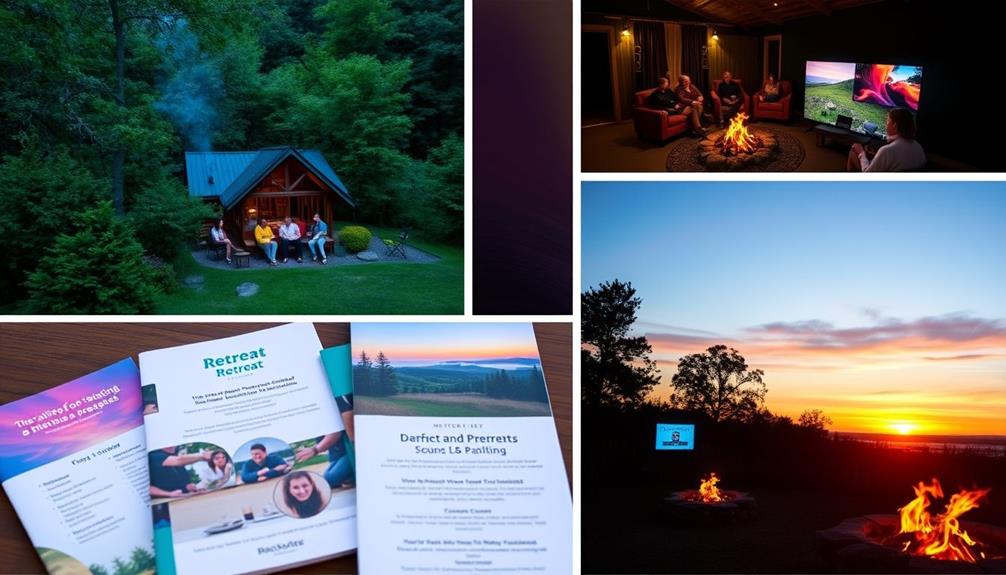
Effective marketing campaigns are essential for drawing attention to your retreat and enticing potential attendees. To craft compelling campaigns, start by developing a unique selling proposition (USP) that resonates with your target audience. This sets your retreat apart and attracts participants effectively. Utilize engaging visuals and narratives in your marketing materials to enhance audience engagement and spark interest.
Here's a quick overview of effective marketing strategies:
| Strategy | Description | Benefits |
|---|---|---|
| Social Media | Use platforms for targeted ads and organic posts | Broader reach and visibility |
| Engaging Content | Create educational, inspirational, and promotional materials | Fosters deeper connections with your audience |
| Leverage Testimonials | Share success stories from past attendees | Builds trust and credibility |
Don't forget to monitor and adjust your campaigns based on audience feedback and engagement metrics. This guarantees your marketing efforts remain relevant and effective. Collaborating with influencers can also amplify your message, reaching a wider audience. By focusing on these elements, you'll engage your audience and increase participation in your retreat.
Fostering Community and Partnerships

Regularly fostering community and partnerships can greatly enhance the overall experience of your retreat. When attendees feel connected, they're more likely to return and share their experiences, boosting attendee loyalty and word-of-mouth referrals.
To create a vibrant community, consider these strategies:
- Collaborate with local businesses and wellness brands: This not only broadens your marketing reach but also enriches the retreat experience. For instance, partnering with local artisans can provide unique decor elements that enhance the ambiance of your space, similar to how cultural decor can add depth to a retreat environment. Offer exclusive deals or services, making attendees feel valued and connected to the local community.
- Host wellness events or online forums: These activities help build relationships among attendees, extending the community beyond the retreat. This ongoing engagement fosters a sense of belonging and shared purpose.
- Engage in influencer collaborations: Partnering with aligned influencers can amplify your marketing efforts. Their authentic endorsements resonate with followers, generating increased interest and bookings for your retreats.
Frequently Asked Questions
How Do I Market My Retreat?
To market your retreat, craft personalized messages that resonate with potential attendees, share engaging content on social media, optimize your website for search engines, partner with influencers, and create urgency through special offers and discounts.
Are Retreats Profitable?
Yes, retreats can be profitable. You'll find profit margins between 20% and 50%, especially if you manage operational costs effectively, offer unique experiences, and implement strategies like early bird discounts to attract more participants.
How Do You Organize a Successful Retreat?
To organize a successful retreat, define your purpose and audience, choose a serene location, create a balanced schedule, promote effectively, and gather feedback afterward to improve future experiences. You'll enhance satisfaction and engagement.
How to Start a Spiritual Retreat Business?
To start a spiritual retreat business, identify your niche and research wellness trends. Create a solid business plan, craft a unique brand identity, and leverage social media and partnerships to attract your target audience effectively.
Conclusion
In the business of retreats, understanding your audience isn't just a theory; it's a game-changer. When you connect with participants on a personal level, you're not just filling spots—you're building a community. By leveraging social media and crafting targeted campaigns, you create lasting relationships that go beyond the retreat itself. Remember, it's not just about marketing; it's about creating experiences that resonate. So, dive deep, engage authentically, and watch your retreat flourish like never before.
- About the Author
- Latest Posts
Introducing Ron, the home decor aficionado at ByRetreat, whose passion for creating beautiful and inviting spaces is at the heart of his work. With his deep knowledge of home decor and his innate sense of style, Ron brings a wealth of expertise and a keen eye for detail to the ByRetreat team.
Ron’s love for home decor goes beyond aesthetics; he understands that our surroundings play a significant role in our overall well-being and productivity. With this in mind, Ron is dedicated to transforming remote workspaces into havens of comfort, functionality, and beauty.
Retreat
Creating a Meditation Room in Your Home: Tips and Ideas
Navigate your way to a tranquil meditation room at home with these essential tips, and discover how to transform your space into a serene sanctuary.
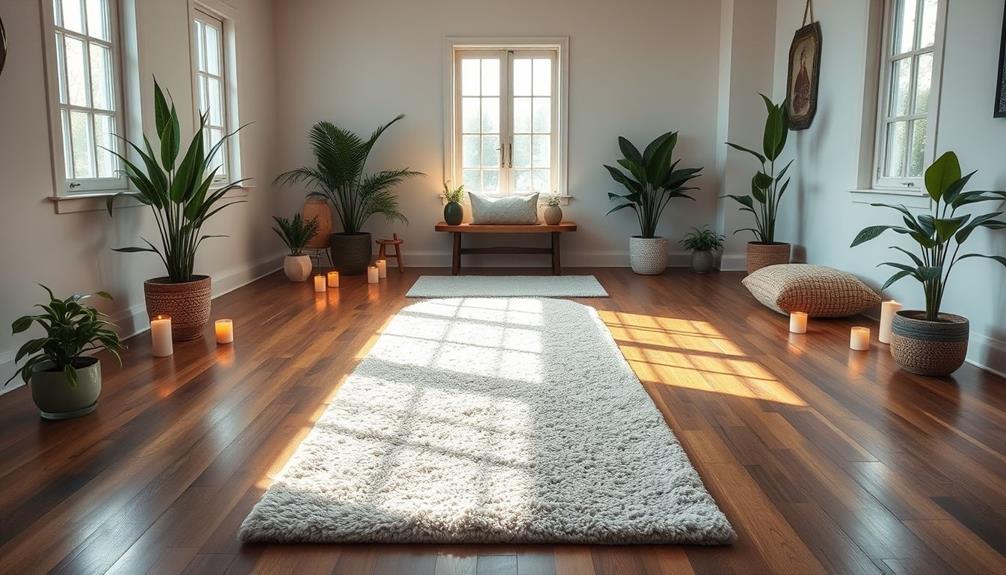
Creating a meditation room in your home can enhance your mindfulness practice. Start by choosing a quiet spot away from distractions. Embrace minimalism; declutter your space and use calming colors. Add personal touches like meaningful decor and cozy textiles to make it inviting. Maximize natural light with large windows and mirrors, and incorporate indoor plants to promote serenity. Enhance the ambiance with gentle nature sounds or a small fountain, and keep the space organized for ease and focus. Follow these guidelines, and you'll create a sanctuary that supports your meditation journey. There's much more to explore on this topic!
Key Takeaways
- Choose a quiet, serene location with natural light and a view of greenery to enhance relaxation during meditation.
- Embrace minimalism by decluttering the space and using calming colors to create a focused environment.
- Personalize the room with meaningful decor, cozy textiles, and soft fabrics to foster a comforting atmosphere.
- Incorporate nature elements like indoor plants and water features to enhance tranquility and connection to the outdoors.
- Enhance ambiance with soothing sounds, such as nature sounds or water fountains, while maintaining cleanliness and order in the space.
Choosing the Right Location

When it comes to creating your meditation room, selecting the right location is crucial for fostering a peaceful environment. Start by choosing a quiet location in your home, away from high-traffic areas. This way, you'll minimize distractions and interruptions during your meditation sessions.
A serene atmosphere is fundamental, and incorporating elements from nature can enhance your experience, much like the scenic views and natural beauty found in New England camping spots. Look for a space that offers plenty of natural light; positioning your meditation area near windows not only enhances your mood but also creates a calming atmosphere.
A view of nature can greatly improve your experience, so aim for a spot where you can see greenery or outdoor scenery. This connection to the outdoors promotes relaxation and mindfulness, making your practice more effective.
Additionally, verify the chosen area has enough space for comfortable movement. You'll want to stretch and change positions without feeling cramped, which is crucial for maintaining focus.
Embracing Minimalism
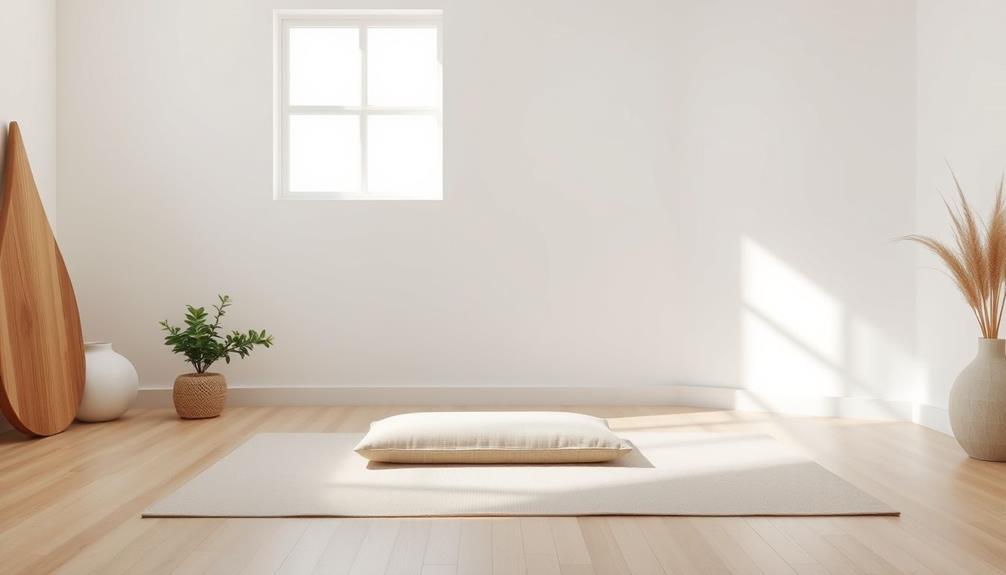
Embracing minimalism in your meditation room can greatly enhance your practice. By simplifying your decor and decluttering, you'll create a space that fosters focus and tranquility.
Prioritizing essential elements allows you to cultivate a calming atmosphere that supports mindfulness and intentional living. Incorporating elements like a simple coffee setup for mindful sipping can further enhance your relaxation, as coffee culture often emphasizes the importance of quality and experience unique offerings in coffee culture.
Simplify Your Decor
Creating a serene meditation room hinges on a minimalist approach that prioritizes simplicity and tranquility. To truly simplify your decor, focus on a clean and uncluttered design that enhances relaxation and reduces distractions. Embracing a balance between technology use and creative expression can also aid in establishing a peaceful atmosphere.
Start by incorporating calming colors like soft neutrals, which help create a relaxing environment free from overwhelming patterns. Limit your decor to essential items. A simple cushion for sitting and a small stool can maintain a no-frills yet stylish atmosphere.
This minimalist meditation room design allows you to concentrate on your practice without unnecessary visual noise. Adding a textured area rug can provide comfort without compromising the overall aesthetic, giving your feet a cozy spot during meditation.
To reinforce the purpose of the space, designate the area solely for meditation. This ownership fosters a deeper connection to the room, enhancing your overall experience.
Declutter for Focus
To achieve true focus in your meditation room, decluttering is essential. Embracing minimalism means removing excess belongings that can disrupt your peace. A distraction-free environment enhances your ability to clear your mind and immerse yourself in your practice, which can be particularly beneficial for individuals experiencing emotional dysregulation, as seen in conditions like Borderline Personality Disorder (BPD).
Start by keeping only the essential items in your space. This approach reduces visual noise, allowing for a more profound and uninterrupted meditation experience.
Consider minimalist decor, like simple cushions and a textured area rug, to create a chic yet calming atmosphere. These elements foster tranquility without overwhelming your senses.
Regularly assess your meditation room and remove items that no longer serve your purpose. This practice not only keeps your space tidy but also nurtures a habit of mindfulness.
As you declutter for focus, you'll find that a clean and uncluttered space promotes serenity and signals your mind to settle into the right headspace for meditation.
Prioritize Essential Elements
A meditation room thrives on vital elements that promote calm and focus. Embracing minimalism in your meditation space means reducing clutter and keeping only items that bring value. This fosters mindfulness and tranquility, important for deepening your practice.
Start by selecting a clean color palette with soft, neutral tones—these hues enhance relaxation and create a serene environment. Additionally, consider incorporating elements that support overall well-being, such as a small indoor plant, which can improve air quality and contribute to a peaceful atmosphere, as seen in natural remedies alongside conventional medications.
Choose multifunctional furniture to optimize your limited space. For instance, a meditation cushion can double as a reading seat or a spot for journaling, maintaining a minimalist aesthetic without sacrificing utility.
It's vital to reserve this area solely for meditation, ensuring it remains distraction-free. This practice not only supports your mental well-being but also reinforces the habit of mindfulness.
Regularly decluttering and organizing your meditation space keeps it inviting and invigorating. By prioritizing essential elements, you create an environment that nurtures both mental and physical health, making it easier to commit to your meditation routine.
Personal Touches and Comfort
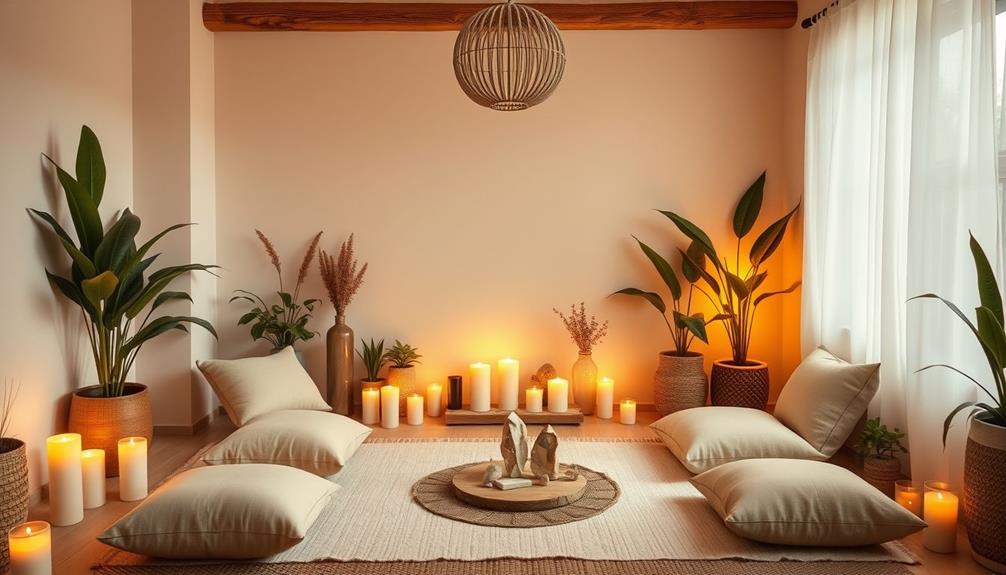
To make your meditation room truly yours, consider incorporating meaningful decor elements that resonate with you.
Choose cozy textiles in colors that calm your mind and enhance your comfort during sessions.
You might also want to explore the benefits of essential oils for relaxation, which can add a soothing aroma to your space.
Personalizing your space not only boosts your emotional connection but also enriches your overall meditation experience.
Meaningful Decor Elements
Creating a meditation room that truly reflects your personal journey involves infusing it with meaningful decor elements that resonate with your practice. By incorporating personal items, you not only enhance the ambiance but also foster a deeper connection to your space.
Think about what inspires you and choose decor that aligns with your meditation goals. For instance, you might find inspiration in heartfelt expressions of love that remind you of those who support your journey.
Here are some ideas to contemplate:
- Meaningful photographs of loved ones or special moments that evoke peace
- Crystals that bring positive energy, helping to ground your practice
- Inspirational quotes framed beautifully to motivate and uplift your spirit
- A vision board that visually represents your meditation goals and aspirations, serving as a constant reminder of your intentions
- Handmade pottery or unique artwork that reflects your individuality and adds character
These personal touches will create a comforting atmosphere, making your meditation sessions more enjoyable.
Cozy Textiles Selection
When selecting cozy textiles for your meditation room, focus on comfort and personal expression. Start with soft, breathable fabrics like cotton or linen for your cushions and throws. These materials enhance your comfort during meditation sessions, making your space more inviting.
Layer your textiles by adding a plush area rug and decorative pillows, which can be complemented by an atmosphere created by well-draining soil essential for preventing root rot. This creates a warm atmosphere that encourages relaxation and helps you unwind.
Opt for textiles in calming colors such as pastel hues or gentle earth tones to maintain a serene environment. These colors not only soothe the eye but also promote tranquility.
Consider incorporating weighted blankets or soft throws that provide a comforting sensation, enhancing your sense of security as you meditate.
Personalize your space further with handmade or unique textile pieces that resonate with your meditation journey. These special touches add individuality to your decor, making the room feel uniquely yours.
The right cozy textiles selection can transform your meditation room into a haven of peace and comfort, inviting you to return often for moments of reflection and relaxation.
Personalization Through Color
A harmonious color palette can truly transform your meditation room into a sanctuary of peace. By choosing soft tonal colors like warm whites, grays, and earthy tones, you can enhance relaxation and create a calming atmosphere. Incorporating calming colors such as blues and greens promotes tranquility while maintaining a cohesive scheme throughout the space.
This thoughtful approach to color selection echoes the importance of effective preparation in design, guaranteeing that your meditation room serves its intended purpose.
To personalize your meditation area, consider adding these elements:
- A soft sage green wall that invites relaxation
- Warm beige cushions that cradle you in comfort
- A pastel blue rug that feels soothing underfoot
- Meaningful artwork that resonates with your meditation goals
- Earth-toned decor items that reflect your personal meaning
These personal touches foster a sense of ownership and connection, enhancing overall comfort during meditation. By displaying meaningful objects, you not only elevate the ambiance but also create gentle reminders of your practice.
Experimenting with pastel hues can guarantee the space remains inviting and serene, making it ideal for deepening your meditation practice. Ultimately, your color choices will help establish a soothing environment, allowing you to fully immerse yourself in tranquility.
Color Choices for Relaxation
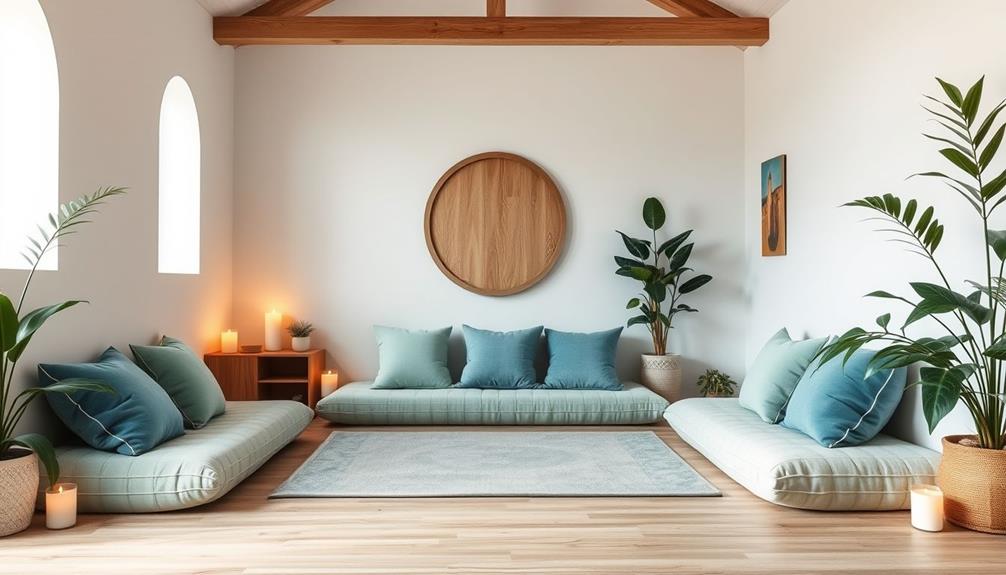
Choosing the right colors for your meditation room can greatly enhance your relaxation experience. Calming colors play an essential role in creating a serene environment, allowing you to focus and unwind. Soft tonal colors like warm whites, grays, and earthy tones are ideal for promoting tranquility. These shades help establish a peaceful atmosphere, making your meditation practices more effective.
To help you choose the best colors, consider the following options:
| Color | Effect |
|---|---|
| Soft White | Promotes clarity and spaciousness |
| Light Blue | Evokes calmness and serenity |
| Earthy Green | Connects to nature and grounding |
Avoid bright and energizing colors, as they can distract you from your goal of relaxation and mindfulness. Instead, aim for a cohesive color scheme throughout your meditation space to enhance the overall calming effect. Remember, your color choices for relaxation can greatly impact your mood, so select shades that evoke tranquility and peace. Create a sanctuary that invites you to pause and reflect, enriching your meditation journey.
Maximizing Natural Light
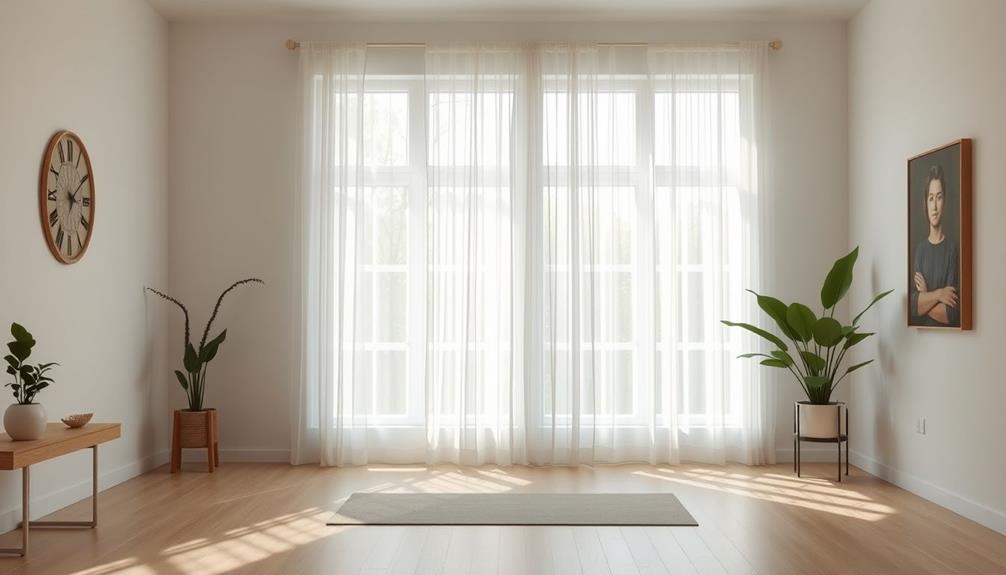
Natural light can transform your meditation room into a haven of peace and clarity. Position your meditation space near windows to take full advantage of the sunlight, which can uplift your mood and enhance relaxation.
Incorporating elements like natural materials can further enhance this calming environment, as seen in modern farmhouse decor trends. To create a serene atmosphere, use sheer curtains that diffuse sunlight while maintaining brightness.
Consider these tips to maximize natural light:
- Large windows that invite in ample sunlight
- Mirrors placed strategically to reflect light deeper into your space
- Light-colored decor and furnishings that amplify brightness
- Unobstructed views by keeping heavy furniture away from windows
- Soft, natural colors that evoke a sense of tranquility
Incorporating Textures
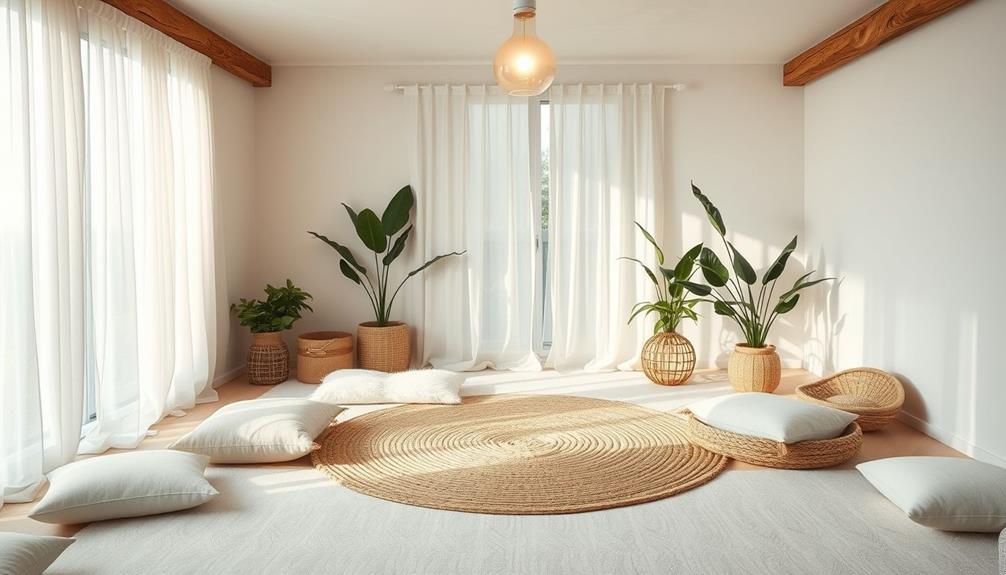
To create a truly calming meditation room, you'll want to focus on soft fabrics like cotton or linen that enhance comfort.
Layering textiles, such as plush rugs and cozy cushions, invites warmth and encourages relaxation.
Soft Fabrics Selection
Incorporating soft fabrics into your meditation room can greatly enhance comfort and create a soothing atmosphere. By selecting materials like cotton, linen, and bamboo, you can guarantee a calming atmosphere for your practice. These breathable fabrics promote airflow and regulate temperature, making your space inviting regardless of the season.
To elevate the sensory experience, consider adding the following elements:
- Plush rugs that cushion your feet and provide warmth
- Soft wall hangings that absorb sound and add texture
- Cozy throws to wrap yourself in during meditation
- Comfy cushions that invite you to sit and relax
- Sheer curtains that filter light and soften the room
Choosing soft fabrics in neutral colors can further enhance the tranquility of your meditation room. These hues create an inviting environment, allowing you to focus inward without distractions.
Layered Textiles Approach
Layering textiles in your meditation room can transform the space into a cozy sanctuary that enhances your practice. By incorporating a variety of soft fabrics—like plush blankets, cushions, and area rugs—you'll create an inviting atmosphere that promotes comfort.
Choose breathable materials such as cotton or linen for your cushions and throws to help regulate temperature, ensuring a pleasant environment during your meditation sessions.
Textured elements, like woven poufs and knitted throws, add visual interest while maintaining a calming ambiance. A soft rug over hardwood floors not only absorbs sound but also contributes to a quieter atmosphere, allowing you to focus more deeply on your meditation.
Utilizing multiple layers fosters a sense of warmth and grounding that's vital for a calming meditation experience. Combining different textures encourages deeper relaxation and mindfulness, enhancing your overall practice.
Creating a Functional Layout

A harmonious layout is essential for creating a meditation room that fosters tranquility and ease of use. When you design a layout, think about functionality and how each area will serve your needs. You want enough space for meditation and other activities without feeling cramped.
Consider incorporating the following elements:
- A cozy reading nook with soft lighting
- A dedicated journaling corner with a small desk
- Comfortable floor cushions spread around for flexibility
- Multi-functional furniture, like a storage ottoman for organization
- A clear pathway that encourages smooth changes between activities
Position your furniture to facilitate natural flow and accessibility. This way, you can easily shift from meditative practices to reading or journaling.
Using comfortable floor cushions or mats allows for movement and adaptability, especially in smaller spaces. By thoughtfully arranging your meditation space, you create an inviting atmosphere that encourages relaxation and mindfulness while enhancing the room's overall functionality.
Adding Nature Elements

Nature's presence can greatly enhance your meditation room, creating a calming sanctuary that invites peace and mindfulness. One effective way to bring nature into your meditation is by incorporating indoor plants. Choosing plants like peace lilies or snake plants not only improves air quality but also fosters a serene atmosphere.
You can also use nature-inspired colors—think earthy greens and browns—to enhance the calming effect of your space. These colors promote relaxation and help you connect more deeply with your surroundings during meditation.
Additionally, consider adding a water feature, such as a small fountain. The gentle sound of flowing water mimics nature and can deepen your meditative experience. It's a beautiful way to create a soothing backdrop that allows your mind to relax.
Positioning your meditation area near windows maximizes natural light, making the space bright and airy. If you have the option, creating an outdoor meditation space with comfortable seating and natural elements like stones and wood will further enhance your connection to nature, enriching your overall meditation experience.
Enhancing Ambiance With Sound
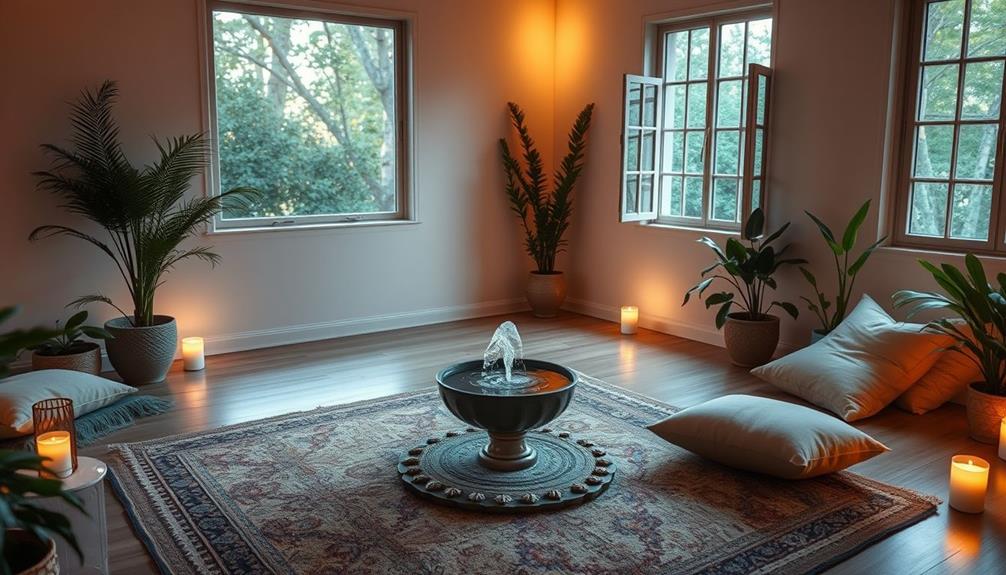
Creating a serene atmosphere in your meditation room isn't just about visual elements; sound plays an essential role too. Incorporating calming sound elements can greatly enhance your relaxation and deepen your meditative experience.
Consider these ideas to elevate the ambiance:
- Gentle nature sounds, like rustling leaves or chirping birds
- A small water fountain providing soothing background sounds
- Soft music playlists that promote mindfulness and focus
- Soundproofing techniques, such as thick rugs and curtains to block external noise
- Experimenting with sound frequencies through singing bowls or sound baths
Maintaining Cleanliness and Order

To maintain a truly peaceful meditation room, regular cleanliness and order are key components. Start with decluttering your space; a clean area helps you focus better and enhances mindfulness during your practice. Make it a habit to tidy up daily, ensuring that surfaces and textiles are kept clean. This routine not only creates an inviting atmosphere but also contributes to a more serene environment for meditation.
Organizing your items for easy access fosters functionality while instilling a sense of calm. Keep only what you need, minimizing distractions that could interrupt your meditation. Clean and fresh textiles, such as cushions and rugs, should be maintained regularly to promote hygiene and comfort. You'll find that a well-organized space allows you to settle into your practice more effortlessly.
Lastly, remember that a clutter-free meditation area enhances your overall experience. By committing to these practices, you'll cultivate a tranquil sanctuary that encourages deeper reflection and relaxation. Maintaining cleanliness and order will transform your meditation room into a true haven, making each session a rewarding escape from the chaos of daily life.
Frequently Asked Questions
How to Set up a Meditation Room in Your Home?
To set up a meditation room, find a quiet corner, use soft colors, and add calming decor. Incorporate comfortable seating and maximize natural light while personalizing with meaningful items to enhance your practice.
How to Make a Zen Room at Home?
Think of your home as a canvas; you can paint a Zen room filled with tranquility. Choose a serene corner, soften colors, add comfy seating, and let nature's touch create your perfect sanctuary for mindfulness.
What Color Should a Meditation Room Be?
Your meditation room should embrace soft tonal colors like warm whites, grays, or earthy tones. Blues and greens promote relaxation, while pastels create an inviting atmosphere. Avoid bright colors to maintain a tranquil environment.
How to Design a Meditation Center?
Designing a meditation center isn't rocket science; just toss some cushions and call it zen! Seriously, pick a quiet spot, add calming colors, comfy seating, and maybe some plants. Voila! Instant tranquility.
Conclusion
Creating a meditation room in your home can transform your space into a sanctuary of peace and relaxation. By thoughtfully selecting your location, embracing minimalism, and adding personal touches, you can craft an environment that resonates with tranquility. Isn't it time you took a break from the chaos and found your calm? With the right colors, natural elements, and soothing sounds, you'll not only enhance your meditation practice but also nurture your overall well-being.
- About the Author
- Latest Posts
Introducing Ron, the home decor aficionado at ByRetreat, whose passion for creating beautiful and inviting spaces is at the heart of his work. With his deep knowledge of home decor and his innate sense of style, Ron brings a wealth of expertise and a keen eye for detail to the ByRetreat team.
Ron’s love for home decor goes beyond aesthetics; he understands that our surroundings play a significant role in our overall well-being and productivity. With this in mind, Ron is dedicated to transforming remote workspaces into havens of comfort, functionality, and beauty.
Retreat
How to Host a Successful Wellness Retreat: A Complete Guide
Unlock the secrets to hosting a transformative wellness retreat that captivates your audience—discover essential tips to elevate your experience beyond expectations!
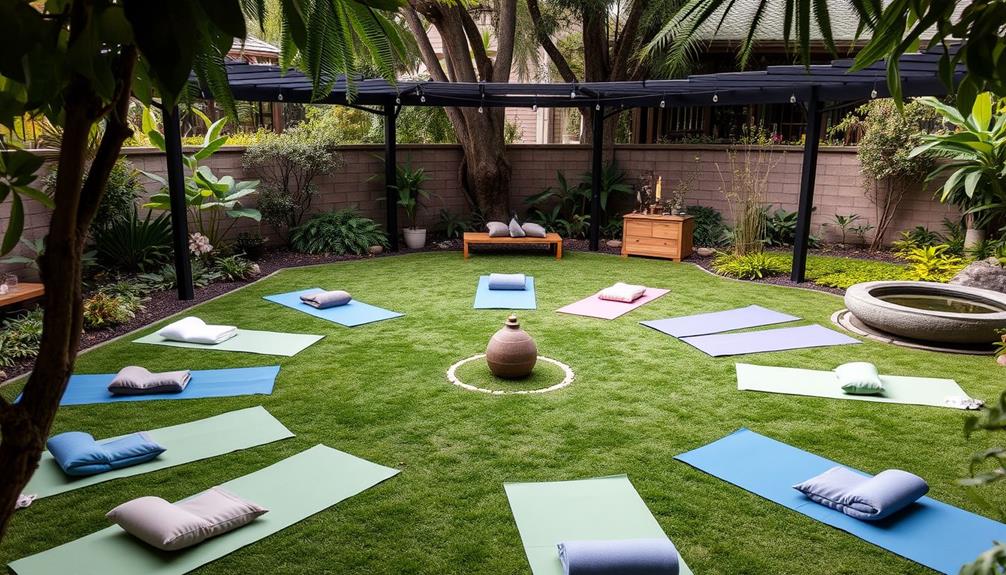
To host a successful wellness retreat, start by defining your target audience to tailor the experience. Select an ideal location that offers serenity and aligns with your theme. Develop a thorough agenda, balancing structured activities with social bonding opportunities. Engage sponsors who resonate with your audience and can contribute relevant resources. Finally, market your retreat effectively using social media and community outreach to generate buzz. Remember, the more you focus on personalizing the experience, the more impactful your retreat will be. There's plenty more to explore to enhance your retreat's success!
Key Takeaways
- Identify your target audience and tailor retreat offerings to their specific interests and logistical needs.
- Select an ideal location that enhances the retreat experience while being financially sustainable.
- Develop a comprehensive agenda that balances teaching, activities, meals, and social bonding for a cohesive experience.
- Engage with relevant sponsors and partners to enhance credibility and provide in-kind contributions for your retreat.
- Implement a robust marketing plan using social media, community outreach, and a professional website to attract participants.
Define Your Target Audience
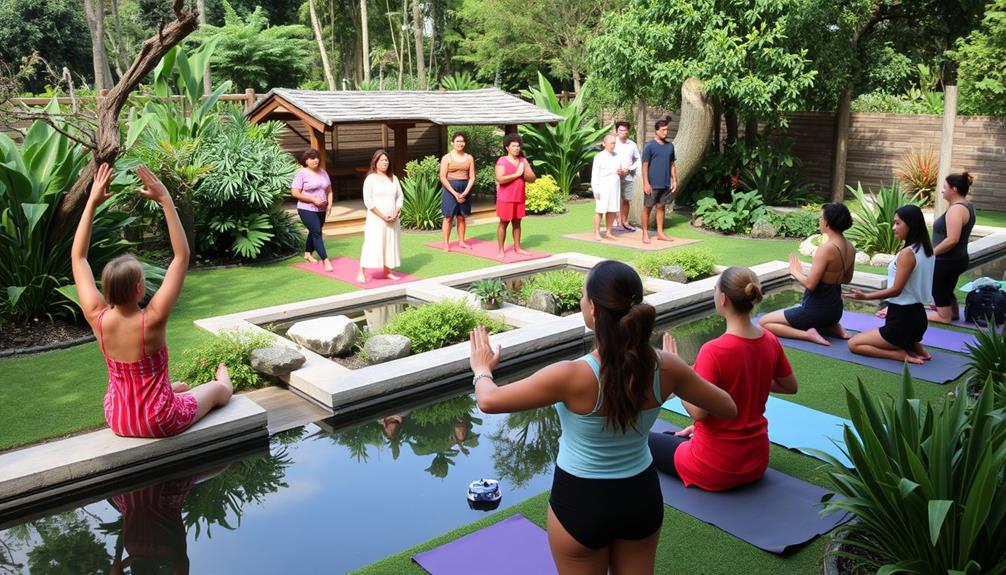
To kick off your wellness retreat planning, you need to nail down your target audience. Identifying who you want to attract is vital for creating a successful retreat that meets specific interests and needs.
For instance, if your target audience includes athletes, focus on fitness-oriented activities. Conversely, busy professionals might appreciate relaxation techniques and mindfulness workshops. Understanding logistical challenges, like travel arrangements for parents, helps you tailor the retreat experience, enhancing participant satisfaction.
Engaging your target audience directly through personalized email invitations can greatly boost participation rates and foster a sense of exclusivity. Consider incorporating elements that enhance well-being, such as cold medications overview, to cater to health-conscious attendees. Building a network of potential attendees even before launching your retreat can lead to increased interest and better engagement. Personal connections often drive attendance.
Additionally, make certain the activities align with your audience's interests. Offer hiking excursions for nature enthusiasts or workshops on stress management for overwhelmed professionals.
Select an Ideal Location
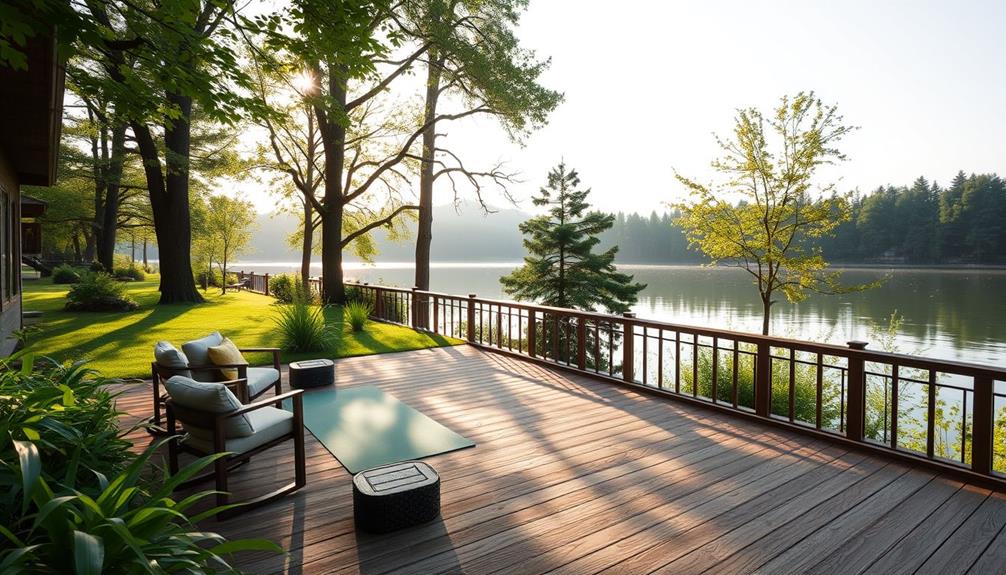
Where should you host your wellness retreat? Selecting the right retreat location is essential for enhancing the overall experience. Choose a place that resonates with your retreat's theme and goals, guaranteeing it offers a serene environment conducive to relaxation and personal growth.
If you're aiming to attract participants from the wellness tourism market, consider local venues that simplify logistics and reduce travel costs, making it easier for attendees to join. For instance, hosting your retreat in a region known for its natural beauty, like New England camping, can provide a picturesque backdrop and foster a deeper connection with nature.
When planning the retreat, make sure venue costs don't exceed 20% of your total budget. This approach maintains financial sustainability, allowing you to invest in other experiences. Evaluate the available amenities and accessibility; look for spaces that support planned activities, such as outdoor areas for yoga or workshops, to create a well-rounded experience.
Additionally, think about the surrounding natural attractions. Engaging with local culture or nature can greatly enhance the wellness experience and provide opportunities for exploration.
Develop a Comprehensive Agenda

Once you've chosen the perfect location for your wellness retreat, it's time to craft a thorough agenda that maximizes participant engagement and satisfaction.
Start by allocating 30% of the retreat day for teaching content and structured activities. This guarantees participants gain valuable insights and skills relevant to their wellness journey. Incorporate diverse activities like cooking demonstrations, workshops, and physical activities to cater to different interests, enhancing the retreat experience.
Additionally, consider integrating energy efficiency strategies into your retreat's activities, as they can resonate with attendees interested in sustainable living.
Next, dedicate 50% of the day to meals and social bonding activities. This fosters connections among attendees and creates a supportive environment where participants can share stories and experiences.
It's essential for building a community atmosphere that encourages collaboration and growth.
Engage Sponsors and Partners
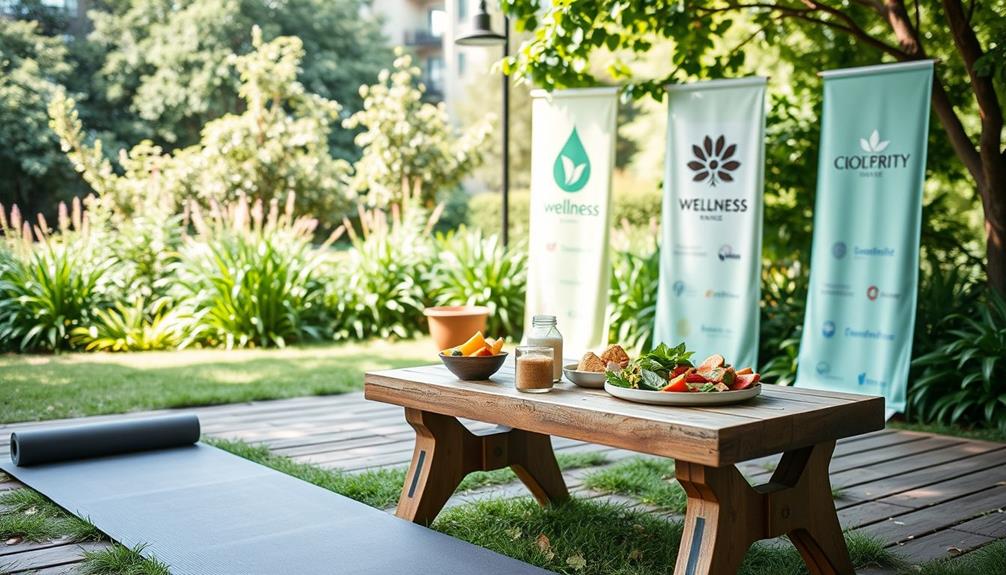
Engaging sponsors and partners can greatly elevate your wellness retreat, providing valuable resources while enhancing the overall experience for attendees. Target sponsors for in-kind contributions, like products or services that align with your retreat's wellness theme. This not only boosts the experience but also helps you avoid considerable costs.
Consider including health-focused products, such as Cranberry Juice for its antioxidant benefits, to enrich your offerings.
Consider establishing a tiered sponsorship model. By offering varying levels of exposure and benefits, you cater to different budget sizes and marketing goals, making it easier for potential sponsors to participate. Build strong relationships by offering opportunities for product placements, goodie bags, and social media shoutouts. This guarantees mutual promotional benefits that can amplify your marketing strategy.
Make certain your sponsors are relevant to your target audience. This increases engagement and enhances the overall retreat experience.
Approach local businesses and wellness brands with established followings. Their involvement can considerably boost attendance and lend credibility to your wellness retreat, making it more appealing to participants.
Market Your Retreat Effectively
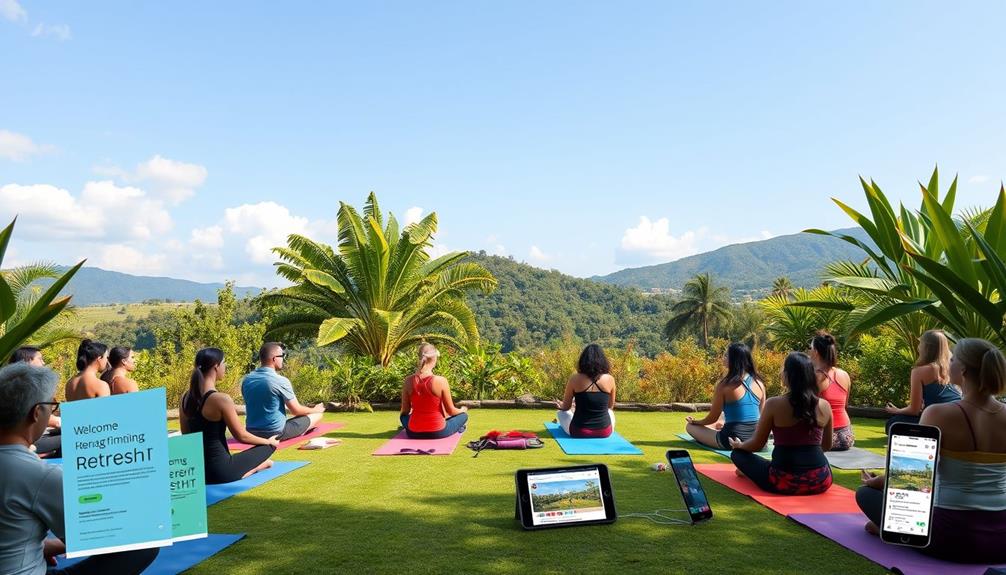
To maximize the success of your wellness retreat, effective marketing is key. Start by developing a thorough marketing plan at least six months before your retreat. This plan should include both online and offline strategies to reach your target audience effectively.
Incorporating high-quality content into your marketing materials can greatly enhance your credibility. Social media campaigns can be particularly powerful; share engaging content, testimonials, and behind-the-scenes glimpses to attract interest.
A professional website is essential. It should serve as a central hub for information, registration, and client testimonials, enhancing your credibility and facilitating bookings. Make sure it's user-friendly and optimized for mobile devices.
Consider leveraging partnerships with wellness influencers or practitioners who already have an established following. Their endorsement can greatly boost your retreat's visibility and create excitement around the event.
Don't forget community outreach. Attend local wellness events or workshops to promote your retreat and connect with potential attendees face-to-face.
Frequently Asked Questions
How to Organize a Successful Retreat?
To organize a successful retreat, define your goals, identify your audience, choose an appropriate location, create a balanced itinerary, engage sponsors, and gather feedback afterward to improve future events. You'll foster a rewarding experience.
How to Design a Wellness Retreat?
Imagine planting a garden; you need clear goals, vibrant themes, and nurturing elements. When you design a wellness retreat, focus on a balanced itinerary, engaging instructors, and diverse activities that cultivate growth and rejuvenation.
Are Wellness Retreats Profitable?
Yes, wellness retreats can be profitable. By effectively pricing tickets, engaging sponsors, and creating valuable experiences, you can attract wellness travelers who often spend more, ensuring sustainability and potential for repeat business.
How to Create a Retreat Agenda?
To create a retreat agenda, allocate time for teaching, structured activities, and meals. Mix in unstructured time for relaxation, and encourage creative interactions among attendees to strengthen connections and enhance their overall experience.
Conclusion
By following these steps, you're well on your way to hosting a wellness retreat that resonates with your audience and leaves a lasting impact. Imagine your participants returning home revitalized, with new insights and friendships forged in your serene setting. Isn't that the kind of experience you want to create? Embrace the journey, engage your community, and watch as your retreat transforms lives, including your own. Now, go out there and make it happen!
- About the Author
- Latest Posts
Introducing Ron, the home decor aficionado at ByRetreat, whose passion for creating beautiful and inviting spaces is at the heart of his work. With his deep knowledge of home decor and his innate sense of style, Ron brings a wealth of expertise and a keen eye for detail to the ByRetreat team.
Ron’s love for home decor goes beyond aesthetics; he understands that our surroundings play a significant role in our overall well-being and productivity. With this in mind, Ron is dedicated to transforming remote workspaces into havens of comfort, functionality, and beauty.
Retreat
The Psychology of Color in Retreat Center Design
Discover how colors in retreat center design influence emotions and well-being, unlocking the secrets to creating a transformative experience. What will you choose?
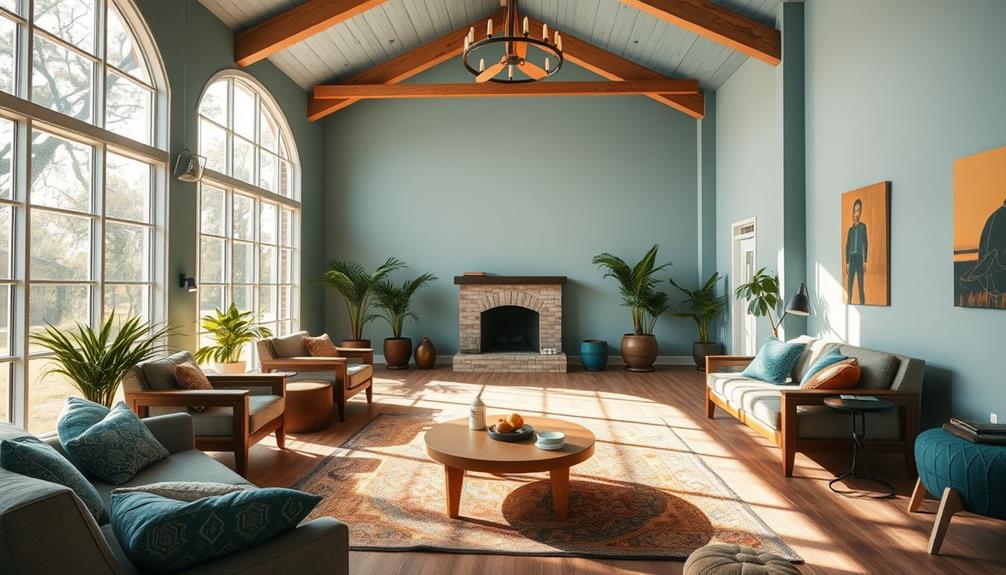
Colors are essential in retreat center design, as they shape your emotions and enhance well-being. Calming blues and tranquil greens promote relaxation and mental clarity, while energizing yellows and oranges lift your mood and spark creativity. Neutral tones provide a soothing backdrop, allowing vibrant accents to pop. Earth tones create a cozy atmosphere, evoking feelings of safety and comfort. Thoughtful color combinations can foster harmony and balance, enhancing your overall experience. Understanding the emotional impact of colors can transform your retreat into a more meaningful space. There's so much more to explore about this fascinating topic.
Key Takeaways
- Colors like blue and green promote tranquility and reduce anxiety, enhancing emotional resilience in retreat settings.
- Warm colors such as yellow and orange uplift mood and stimulate creativity, fostering a vibrant atmosphere.
- Neutral tones provide a calming foundation, reflecting natural light and promoting relaxation and mindfulness.
- Earth tones create a cozy, grounding environment, enhancing feelings of safety and encouraging social interactions among guests.
- Understanding cultural significance of colors can enhance visitor experiences by shaping emotional responses in retreat center design.
Impact of Color on Emotions
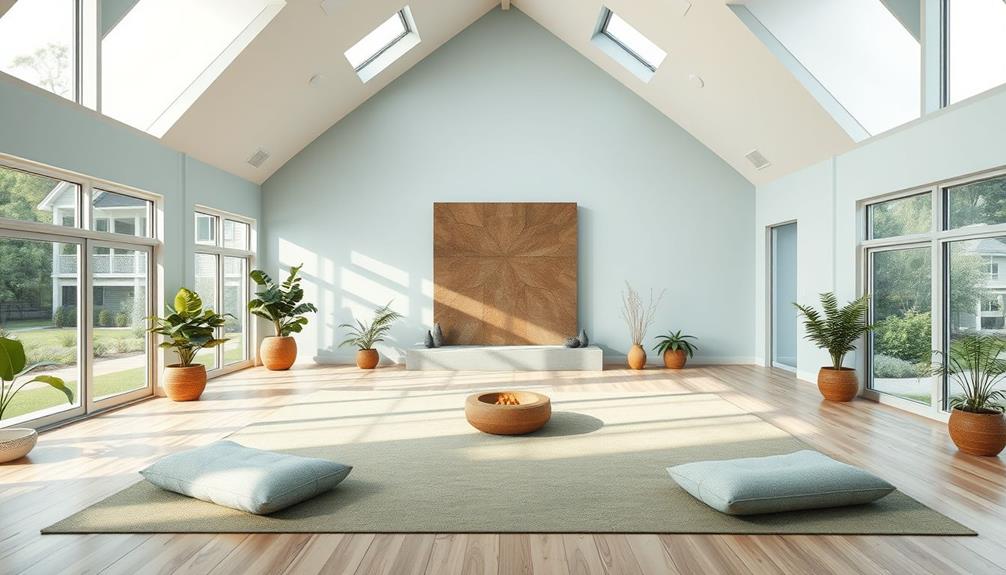
How does color influence your emotions? The colors surrounding you play a significant role in shaping how you feel.
For instance, calming hues like blue and green can evoke tranquility, making them perfect for spaces designed for relaxation. These colors not only create a serene atmosphere but also enhance emotional resilience, helping individuals cope with challenges they may face during their stay.
When you encounter lighter shades of blue, you might notice a reduction in anxiety and a sense of openness that allows you to breathe easier.
In contrast, warm colors such as yellow and orange can elevate your mood, sparking creativity and enhancing social interactions. These vibrant colors can energize communal areas, encouraging connection and collaboration among visitors, much like the supportive community emphasized in Kelly O'Donnell's weight loss journey.
Meanwhile, neutral tones like beige and soft gray create a soothing backdrop, fostering comfort and stability—essential elements for a peaceful retreat experience.
Calming Effects of Blues
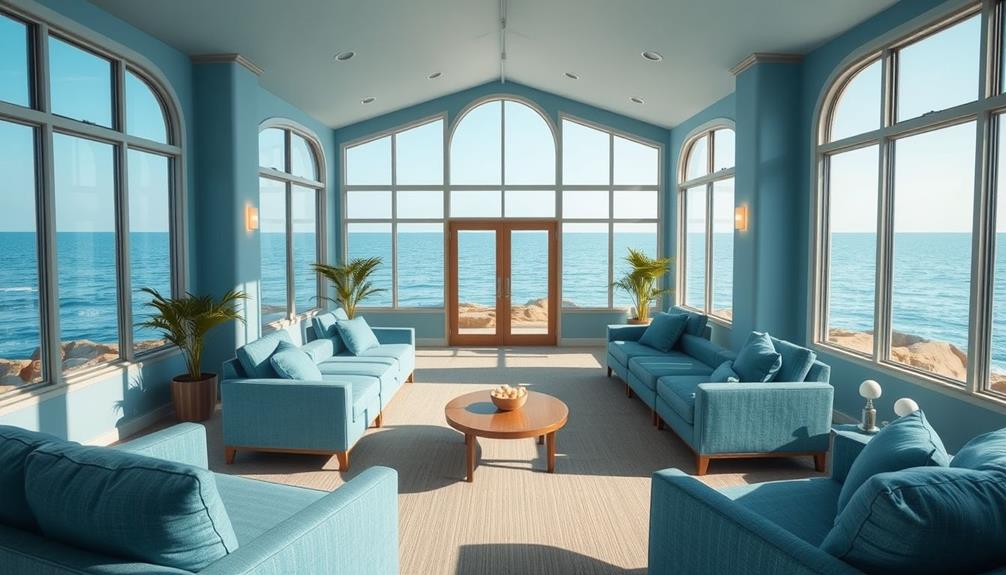
When you step into a space adorned with calming blues, you might instantly feel a wave of tranquility wash over you. These softer shades, like sky blue, are known to lower blood pressure and reduce anxiety, making them perfect for retreat centers focused on relaxation. The color blue evokes feelings of serenity and peace, enhancing the overall atmosphere and allowing you to unwind and rejuvenate.
Incorporating calming blues into retreat center design aligns with principles of design thinking that emphasize user experience and emotional connection. This approach not only enhances the ambiance but also nurtures an imaginative mindset among retreat participants.
Incorporating calming blues into retreat center design creates a sense of openness and clarity. This inviting environment is conducive to reflection and meditation, helping you find your inner calm. Research shows that being surrounded by blue hues can stimulate mental clarity and enhance focus, which supports mindfulness practices often emphasized in these settings.
Moreover, when you combine calming blues with natural light, it amplifies feelings of wellness and connection to nature. This synergy promotes a peaceful and restorative experience, encouraging you to fully immerse yourself in the retreat.
Tranquil Greens for Healing
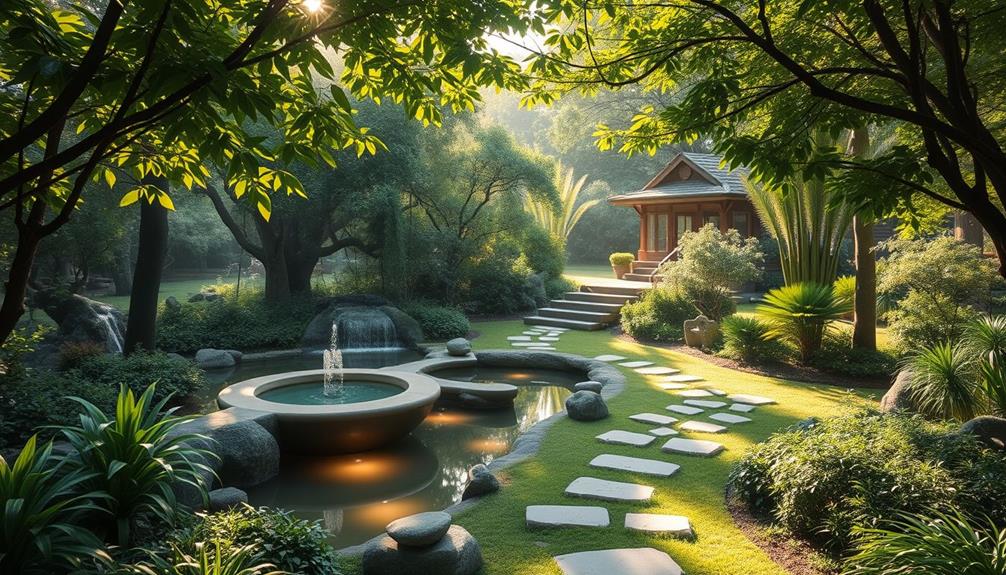
Stepping into a space awash with tranquil greens instantly connects you to nature's calming embrace. These soft green hues don't just beautify a retreat center; they also play an essential role in fostering a healing atmosphere. Studies show that tranquil greens can considerably reduce anxiety, allowing you to feel more at ease and open to relaxation.
Additionally, creating a serene environment can enhance your overall well-being, similar to how cold medications are selected for effective relief during times of discomfort.
Incorporating various shades of green, from gentle pastels to deeper forest tones, creates a soothing ambiance that invites mindfulness and meditation. When you're surrounded by greenery, whether indoors or outdoors, you're likely to experience lower stress levels and an improved mood.
This connection to nature enhances restorative experiences, making the environment feel inviting and conducive to healing.
As you settle into a space filled with tranquil greens, you may notice a sense of harmony washing over you. This feeling promotes overall well-being, vital for any retreat center focused on rejuvenation and relaxation.
Energizing Yellows and Oranges

When you think about the impact of color in retreat centers, energizing yellows and oranges stand out for their mood-boosting effects.
These colors can enhance problem-solving abilities and boost mental health, creating an environment that fosters positivity and resilience, much like the benefits of curiosity.
Yellow can instantly lift spirits and promote a sense of optimism, while orange sparks creativity and enthusiasm among guests.
Mood-Boosting Yellow Effects
Incorporating energizing yellows and oranges into retreat center design can greatly uplift the mood of guests, as these vibrant colors are linked to happiness and optimism.
Yellow, often associated with warmth and cheer, stimulates mental activity and encourages a sense of comfort. This is reminiscent of the way various brewing methods affect the overall coffee experience, creating an inviting atmosphere that promotes positive interactions and enhances creativity among guests.
Bright yellow accents can invigorate spaces, fostering enthusiasm and engagement. In areas designed for social interaction, this uplifting color encourages guests to connect and share experiences. Utilizing yellow in moderation guarantees you avoid overstimulation while still enjoying its energizing effects.
Orange, with its blend of yellow and red, adds an extra layer of excitement and warmth, making it ideal for spaces meant to invigorate visitors.
Together, yellow and orange create a revitalizing environment that not only uplifts spirits but also encourages collaboration and creativity. By thoughtfully integrating these colors into your retreat center, you'll cultivate a vibrant atmosphere that leaves guests feeling energized and inspired.
Creative Energy From Orange
Orange is a powerhouse of creativity and enthusiasm, making it a perfect choice for communal spaces and activity areas in retreat centers. This vibrant color is known to stimulate creativity, encouraging collaboration and interaction among participants.
When you incorporate orange into your retreat center's design, you elevate energy levels and foster a sense of warmth that enhances the group experience. Spaces designed for relaxation, such as those near water features, can further benefit from this energizing hue, as they create a dynamic ambiance that supports both fun and tranquility, similar to the diverse experiences found in water parks.
Using orange in small accents or feature walls invigorates the atmosphere without overwhelming anyone. This balance between stimulation and comfort is essential for environments designed for workshops and group activities. The presence of orange can lead to increased social interaction and a profound sense of belonging, which enriches your retreat experience.
To create a harmonious environment, consider pairing orange with calming colors like blue or green. This combination fosters both creativity and relaxation, allowing participants to feel energized yet comfortable.
The Power of Neutrals
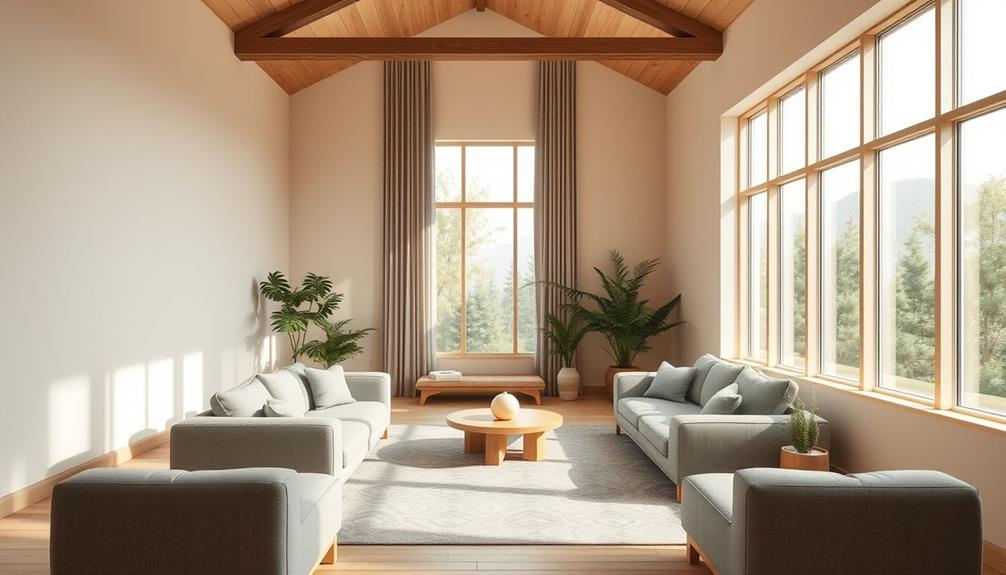
Neutral colors wield incredible power in retreat center design, offering a calming foundation that fosters tranquility. When you choose shades like beige, cream, or pale gray, you create a relaxing canvas that enhances the overall serenity of the space.
These neutral colors reflect natural light effectively, promoting a sense of openness and spaciousness that invites freedom and relaxation. By incorporating elements like DIY fire pit ideas, you can further enhance the outdoor areas, creating a cohesive and soothing environment that complements the indoor aesthetic.
Incorporating soft neutrals contributes to an inviting ambiance, making guests feel more comfortable and at ease—crucial for a peaceful retreat experience. This comfort allows for deeper mindfulness and personal reflection, essential for rejuvenation.
The versatility of neutral shades also enables seamless integration with other color combinations, allowing you to craft harmonious spaces that cater to various emotional needs without overwhelming the senses.
By prioritizing neutral colors in your retreat center design, you not only support a serene environment but also create a backdrop that encourages introspection and tranquility.
Ultimately, these understated tones are powerful tools that elevate the atmosphere, helping visitors find solace and peace during their stay. Embrace the power of neutrals for a transformative retreat experience.
Earth Tones for Grounding
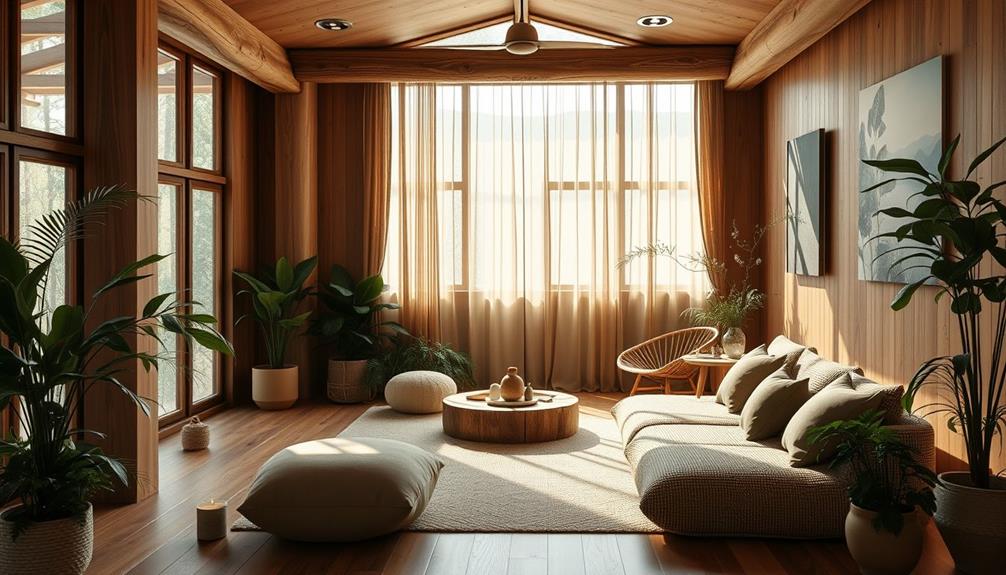
When you incorporate earth tones like warm browns and muted oranges into your retreat center design, you create a nature-inspired color scheme that fosters a cozy atmosphere.
These colors not only evoke feelings of peace and comfort but also promote emotional stability, making your space feel inviting and restorative.
Additionally, the calming effects of such hues can enhance overall wellness, similar to how juice diets contribute to a holistic approach to health.
Nature-Inspired Color Schemes
The calming embrace of earth tones in your retreat center's design can create an atmosphere that fosters tranquility and grounding. By incorporating warm browns and muted oranges, you evoke a sense of comfort reminiscent of serene environments like cabins or beachside escapes.
These earth tones help establish a grounding effect, making them ideal for spaces meant for relaxation and mindfulness. Modern Farmhouse Decor Trends emphasize the importance of natural materials and neutral palettes, which can enhance the connection to the earth in your design.
Soft greens, a beautiful subset of earth tones, further enhance this connection to nature. When you use these shades, you promote a sense of well-being and harmony within your retreat environment.
Imagine guests entering a space where the colors reflect the tranquility of lush forests or gentle meadows, instantly helping them feel at peace.
Utilizing a palette of earth tones not only transforms your retreat center into a cozy sanctuary but also nurtures mental and emotional health. This serene atmosphere becomes a backdrop for meditation and reflection, allowing individuals to fully immerse themselves in the experience.
Cozy Atmosphere Creation
Creating a cozy atmosphere in your retreat center involves more than just choosing the right furniture; it's about how colors interact with the space to evoke warmth and comfort. Earth tones—like warm browns, muted oranges, and soft greens—play an essential role in this process.
These colors create a cozy atmosphere reminiscent of natural environments, promoting relaxation and a sense of tranquility. Incorporating elements such as essential oils for relaxation can further enhance the soothing effect of these hues, creating a multi-sensory experience for your guests.
When you incorporate earthy hues, you connect your guests to nature, enhancing their feelings of safety and security. This connection is fundamental in retreat settings, where peace and restoration are the primary goals.
Earth tones also encourage social interactions, fostering a sense of community among guests. Using natural materials alongside these colors can further enhance the aesthetic appeal of your center.
Imagine a space filled with rich, grounding shades that invite people to unwind and engage. By thoughtfully selecting earth tones, you not only beautify your retreat center but also establish an inviting ambiance conducive to healing and relaxation.
Your choice of colors can transform the experience, ensuring that guests leave feeling rejuvenated and connected to the world around them.
Emotional Stability Through Color
Colors have a powerful influence on our emotions, and earth tones are particularly effective in fostering emotional stability. When you walk into a space adorned with warm browns and muted oranges, you immediately feel a calming atmosphere that echoes the serenity of nature.
These earthy shades create a grounding environment, helping you connect with your surroundings and evoking feelings of peace and tranquility.
In retreat center design, incorporating earth tones is essential for cultivating warmth and comfort. Research shows that these colors can greatly reduce stress and anxiety, making them ideal for spaces dedicated to healing and relaxation.
As you immerse yourself in a well-balanced palette of earth tones, you'll notice an enhanced sense of security and stability, which is critical for emotional well-being.
The serene ambiance created by these colors encourages introspection and emotional balance, which are fundamental for personal growth during your retreat experience.
Pastels for Soft Atmospheres
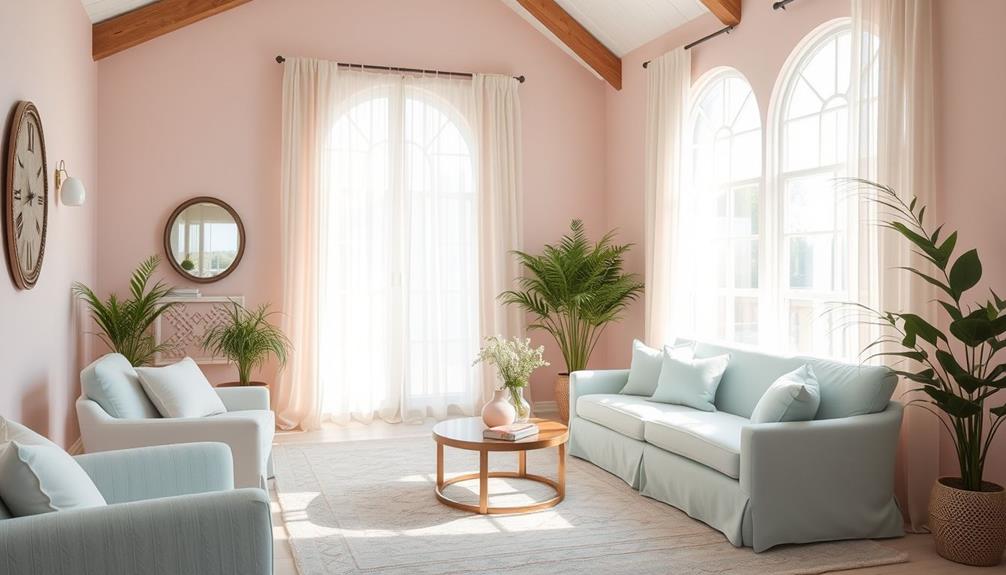
Soft atmospheres in retreat centers can be beautifully achieved with pastel shades like lavender and pale pink. These gentle colors evoke relaxation and tranquility, making them perfect for creating a calm environment.
When you use pastels like mint green and baby blue, you enhance the overall experience for guests seeking rest and rejuvenation.
Incorporating pastels into your retreat center's design helps soften spaces and contributes to a welcoming ambiance. This encourages guests to unwind and feel at ease.
Additionally, combining pastels with whites can enhance the perception of spaciousness and clarity, creating an airy feel that's conducive to meditation and reflection.
Using pastel colors in communal areas fosters a sense of harmony and connection among guests, supporting your retreat's goal of promoting well-being and mindfulness.
This approach not only cultivates a serene atmosphere but also invites visitors to engage deeply with their surroundings, enhancing their overall experience.
Ultimately, by thoughtfully integrating these calming hues, you can transform your retreat center into a sanctuary that nurtures the mind, body, and spirit, making it a true haven for relaxation and rejuvenation.
Color Combinations and Harmony

Achieving harmony in retreat center design involves thoughtful color combinations that evoke a sense of peace and balance. You can create a balanced atmosphere by pairing soothing blues with earthy greens, fostering relaxation and tranquility.
Utilizing analogous color schemes, where colors sit next to each other on the color wheel, enhances visual harmony and contributes to a serene environment.
When you combine calming pastels with soft neutrals, you soften spaces, promoting a sense of peace ideal for bedrooms and meditation areas. The strategic use of contrasting colors can also draw attention to specific areas, like communal spaces, while still maintaining an overall sense of cohesion through grounding earth tones.
Understanding the emotional impact of these color combinations is essential. For instance, blending warm yellows with cool blues can create a dynamic yet calming environment that supports both social interactions and individual reflection.
Cultural Significance of Color

When designing a retreat center, you can't overlook how different cultures interpret colors.
Each hue carries unique meanings that can evoke strong emotional responses, shaping visitors' experiences.
Color Symbolism Across Cultures
Color symbolism plays a vital role in shaping our perceptions and emotions across various cultures. It's important to recognize that the meanings of colors can differ markedly depending on cultural context.
For instance, while white symbolizes purity and peace in many Western societies, it may represent mourning and death in some Eastern cultures. Similarly, red is viewed as a color of good fortune and celebration in Chinese culture, yet in South Africa, it can signify loss.
In Indigenous cultures, colors are often linked to nature and spirituality; blue typically represents water and healing, while green embodies life and growth. Yellow can evoke feelings of happiness and prosperity in Hinduism but may also imply caution in Western contexts.
Understanding these cultural significances is essential when making thoughtful color choices for retreat center design. By considering color symbolism, you can influence emotional responses and perceptions, creating an inclusive environment that resonates with diverse visitors.
Emotional Responses to Colors
Recognizing the cultural significance of colors helps in understanding their emotional impact. Each color can evoke a range of emotions based on cultural context. For instance, while blue is often seen as calming and tranquil, some cultures associate it with sadness. Similarly, red may symbolize strength in certain African cultures, but it could also represent danger elsewhere.
To help you grasp these diverse emotional responses, here's a quick reference table:
| Color | Emotional Response |
|---|---|
| White | Purity (West), Mourning (East) |
| Blue | Calmness (Global), Sadness (Some) |
| Red | Strength (Africa), Danger (West) |
| Green | Fertility (Africa), Safety (West) |
| Yellow | Happiness (West), Caution (Some) |
Understanding these nuances is essential in retreat center design. By carefully selecting colors that resonate positively with your guests' cultural backgrounds, you can create a calming and emotionally uplifting environment. This approach not only enhances their psychological experience but also fosters a deeper sense of connection and belonging during their stay.
Practical Applications in Design
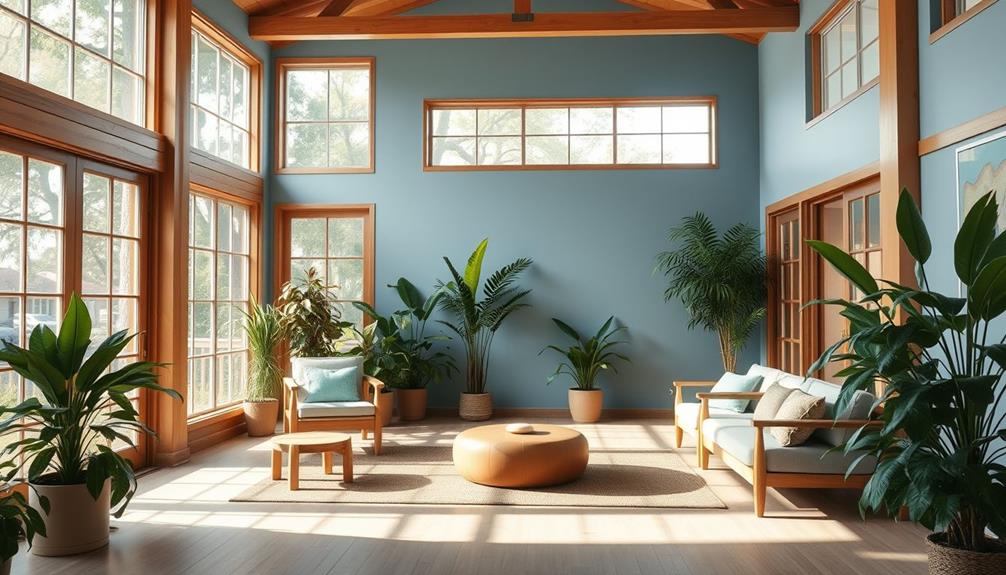
Incorporating thoughtful color choices into retreat center design can greatly enhance the overall guest experience. By selecting calming colors, you create an environment that encourages relaxation and healing. Here are some practical applications to contemplate:
- Use calming blues and greens: These shades foster serenity, helping to reduce anxiety among guests.
- Incorporate neutral shades: Beige and soft gray can serve as a backdrop, allowing you to introduce vibrant accent colors for a balanced atmosphere.
- Utilize earth tones: Warm browns and muted oranges evoke feelings of comfort and a connection to nature, enhancing tranquility.
- Choose pastel colors for personal spaces: In bedrooms and bathrooms, pastels promote restful sleep and a soothing ambiance, essential for a retreat experience.
Strategically placing these colors throughout the retreat center can greatly influence guests' emotional well-being.
Focus on communal spaces and treatment areas to support their journey toward healing and self-discovery.
Frequently Asked Questions
What Are the Psychological Effects of Color in Design?
Colors considerably impact your emotions and perceptions. For instance, blue soothes, yellow uplifts, and greens promote harmony. By understanding these effects, you can create spaces that evoke desired feelings and enhance your overall experience.
What Is the Psychology of Color in Interior Design?
You might think bold colors energize spaces, but they often overwhelm. In interior design, calming hues like blues and greens create serenity, while soft neutrals invite light, transforming chaos into a peaceful retreat for your mind.
What Are the Relaxing Colors Theory?
Relaxing colors, like soft blues and greens, soothe your mind and body. Pastels enhance your tranquility, while earthy tones connect you to nature. Neutral shades create a peaceful atmosphere, promoting relaxation and mental clarity during stressful times.
What Is the Psychology of Colors in Architecture?
In architecture, colors influence emotions and perceptions. You'll find cool hues promote calmness, while warm tones energize. Neutral shades create comfort, making your space feel inviting and balanced, ultimately enhancing your overall experience.
Conclusion
In designing your retreat center, remember how colors can shape emotions and experiences. Just as you find calm in a blue sky or feel energized by a bright yellow sun, your visitors will too. By blending tranquil greens with soft pastels, you create a harmonious atmosphere that invites healing and relaxation. Coincidentally, when you pay attention to the cultural significance of colors, you'll not only enhance the space but also connect deeply with those who seek solace there.
- About the Author
- Latest Posts
Introducing Ron, the home decor aficionado at ByRetreat, whose passion for creating beautiful and inviting spaces is at the heart of his work. With his deep knowledge of home decor and his innate sense of style, Ron brings a wealth of expertise and a keen eye for detail to the ByRetreat team.
Ron’s love for home decor goes beyond aesthetics; he understands that our surroundings play a significant role in our overall well-being and productivity. With this in mind, Ron is dedicated to transforming remote workspaces into havens of comfort, functionality, and beauty.
-

 Retreat5 days ago
Retreat5 days agoDIY Aromatherapy Diffusers for a Spa-Like Atmosphere at Home
-

 Retreat1 week ago
Retreat1 week agoThe Profitability of Retreat Centers: A Financial Analysis
-

 Retreat1 week ago
Retreat1 week agoUnusual DIY Projects: Designing a Space Probe in Bitlife
-

 Retreat2 weeks ago
Retreat2 weeks agoComprehensive Review: Are Home Decorators Ceiling Fans Worth the Investment?
-

 Retreat2 weeks ago
Retreat2 weeks agoStep-By-Step Tutorial: Reupholstering a Chair With Buttons
-

 Retreat1 week ago
Retreat1 week agoIs Opening a Home Decor Store Profitable in 2024?
-

 Retreat6 days ago
Retreat6 days agoHow to Create a Zen Garden for Your Retreat Center
-

 Retreat2 weeks ago
Retreat2 weeks agoThe Ultimate Guide to Baking Acrylic Paint on Ceramic Mugs











